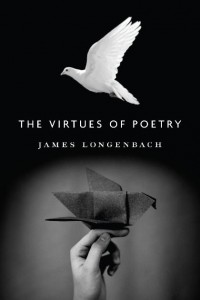

The Virtues of Poetry by James Longenbach (Graywolf Press, 2013)
I have to admit that I’ve been in a rut lately. I’ve been feeling distracted and drained as a reader and a bit blocked as a writer. That’s not quite right; I’ve had good ideas, but no focus to work them out on the page. There are myriad reasons for this and I’m doing what I can to address them, but I want to talk specifically about one tactic: reading books on craft.
I’ve struggled to read poetry over the last month, which is frustrating because reading helps me focus and often leads me to my desk to write. Trying to break out of this rut, I’ve turned to and found solace in short works that change the way I read poetry. Rilke’s Letters to a Young Poet was the first such book I ever encountered in college, and I recently re-read A Poetry Handbook: A Prose Guide to Understanding and Writing Poetry by Mary Oliver. I also love “Feeding the Mind” by Lewis Carrol and Graywolf Press’ The Art Of… series. Also from Graywolf Press is a graceful collection of linked essays by James Longenbach called The Virtues of Poetry.
Longenbach tells us “the word virtue came to English from Latin, via Old French, and while it has acquired a moral valence, the word in its earliest uses gestured toward a magical or transcendental power [….]” Longenbach is interested in examining the magic beneath poems, looking closely at their inner workings to understand how they operate. Here Longenbach excels, providing surprising contrasting poems to examine in similar ways—Whitman and Louise Glück in “Infinitude,” Shakespeare, Elizabeth Bishop, and T.S. Eliot in “Writing Badly.”
In “Less Than Everything” Longenbach tackles Pound’s radical compression by first presenting Herbert Giles “badly written,” tone-deaf translation of a Chinese poem. Pound adapted Giles’ poem into his own poem, “Fan-Piece, for her Imperial Lord,” compressing the piece into three-lines, and just eighteen words. Of Pound’s poem Longenbach writes, “If this translation does not sound to us like a mockery of Chinese poetry, it is because Pound invented the poetic idiom with which we now associate Chinese poetry[.]” This radical compression, Longenbach contends, “has in many ways determined the direction of poetry in our language for the past hundred years[.]”
What makes Longenbach a careful critic, however, is his willingness to complicate the conclusions he draws. Pound may have determined the direction of poetry in the last century, but Longenbach ends his chapter on compression by asking how “we recognize the work of lines that flirt with what we might otherwise call bad writing.” In other words, how can other techniques be blended with Pound’s compression to achieve other worthwhile effects in poems?
Of course, the conclusions Longenbach comes to in answering or attempting to answer these questions might not be to your taste. Indeed, I’ve found that reading texts on craft that aren’t to my taste is useful in bringing my own ideas about writing into sharper focus. Craft essays enter into a conversation about literature that can alter the way one reads a given text and offer thoughts on how an author created a piece. I look for several things when reading about craft, including things to argue against and new things to read. The Virtues of Poetry gives both, along with plenty of things to agree with as well.
I’ve struggled to read poetry over the last month or so, but Longenbach’s essays have given me dozens of ideas, several new authors to read, and a renewed excitement about poetry, both as a reader and a writer. I can’t think of higher praise for a book of essays than that.
Which brings me to a personal plea: What essays and books on craft have you found value in? The next time I find myself in a rut, where should I turn?





